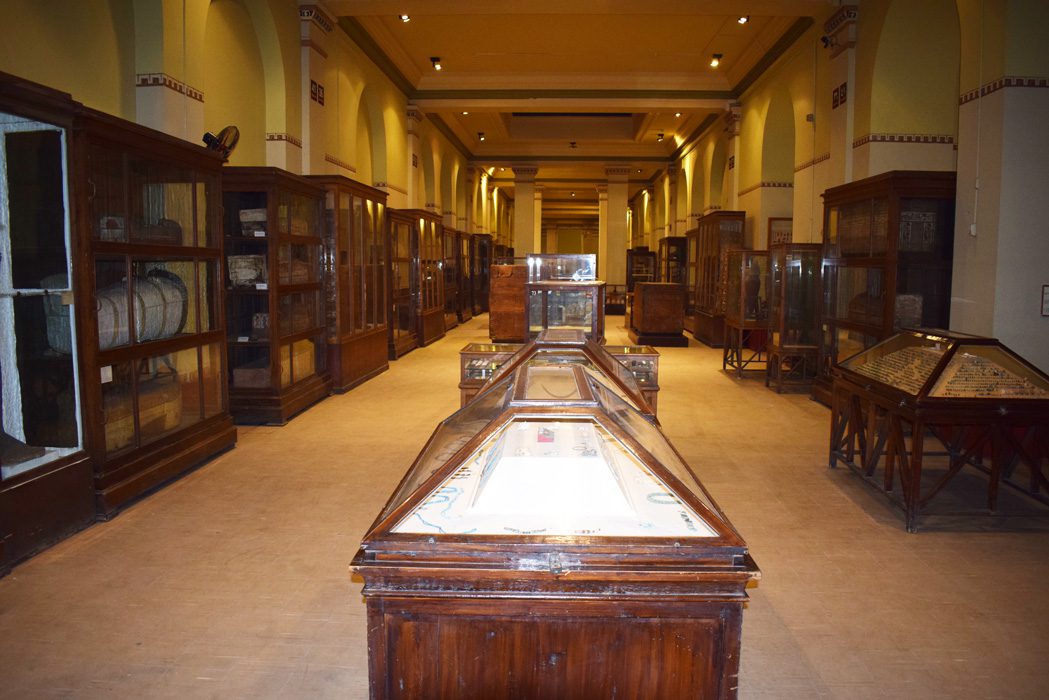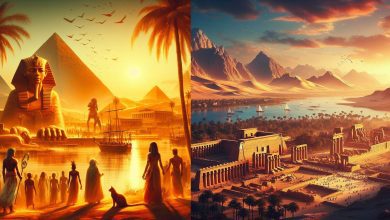Cairo Museum: Display of the Ancient Royal Kingdom

- Largest Pharaonic Museum in The World
- Over 120,000 Artifacts
- One of World Leading Museum
Egypt tour can not completed without a visit to the Egyptian Museum in Cairo. With over 120,000 artifacts, the museum houses an unbelievable exhibit depicting ancient Egypt’s glorious reign. Mummies, sarcophagi, pottery, jewellery and of course King Tutankhamen’s treasures, it’s all there.
The boy-king’s death-mask – discovered in its tomb – is made of solid gold and it has been described as the most beautiful object ever made.
The Egyptian Museum was the first museum in Egypt to be designed with massive internal spaces to house a large number of Pharaonic monuments. The 12 building features a symmetrical and T-shaped composition along a main and perpendicular north-south axis with the Grande Galerie Centrale in its middle, accentuated by rows of arches and columns on its longitudinal sides. The Galerie d’Honneur runs perpendicular to it and parallels to the museum’s south facade. It is designed as a sequence of double-height rectangular and circular spaces from east to west, with a Rotunda in the centre, located right after the museum’s main entrance.
For more than one hundred years, the Egyptian Museum has been a landmark in the centre of downtown Cairo renowned for housing the world’s largest collection of Pharaonic art. The Egyptian Museum was built at a time when museums were established in urban centres to foster greater sensitivity to national identity. The notable density of artifacts in this one-of-a-kind museum attests to the staggering cultural heritage of Egypt’s first civilization, continuously attracting visitors from all over the world. Equally significant is the museum’s 19th-century Beaux-Arts architecture, which provides a dignified setting for an exceptional collection.

At a Look about Egyptian Museum
Location: Tahrir Square, Down Town, Cairo. Google Map Link
Visiting Hours
- Day Shift : 9 AM to 4.30 PM,
- Evening Shift : 6 PM to 8.30 PM
Facilities
- health and hygiene safety Controlled
- Wheel Chair Access
- fully air-conditioned
- Clean Toilet
- Inhouse Restaurant
- Souvenir Shop
- International ATM and Money Exchange
- Instant Multilingual Guide Hiring
- Nearby Car Parking
Average Duration of Visit: 5 Hours
Ticket Price: Please Visit the Egyptian Touristic sites Directory page for the Latest Updated amounts and Offers.
History of Cairo Museum/Egyptian Museum
The Egyptian Museum of Antiquities contains many important pieces of ancient Egyptian history. It houses the world’s largest collection of Pharaonic antiquities. The Egyptian government established the museum built in 1835 near the Ezbekeyah Garden and later moved to the Cairo Citadel. In 1855, Archduke Maximilian of Austria was given all of the artifacts by the Egyptian government; these are now in the Kunsthistorisches Museum, Vienna.
Early Modern Age Arceologcal Collection
The 1798 French expedition to Egypt under Napoleon Bonaparte was the first to bring to general attention the value of Egypt’s ancient heritage, catching the interest of Khedive Mohamed Ali, who issued the first decree in 1835 regulating the excavation of archaeological sites. His decree also prohibited artifacts from being sold and exported out of Egypt without permission. In 1848, the Khedive established the first antiquities storage warehouse, situated in the Cairo district of Azbakia. This storage space soon became congested with antiquities and was broken into by robbers several times.
In 1851, under the reign of Abbas I, the antiquities were transferred from the Azbakia warehouse to one of the halls within the Citadel of Saladin. Regrettably, however, in 1854, Khedive Abbas gave all of these Pharaonic artifacts to the Prince of Austria, who had shown great interest in them during his visit. The Prince returned to Austria with this incredible treasure.
French Egyptologist Chapter
In 1858, Khedive Said appointed the French Egyptologist Auguste Mariette as Director of the newly established Antiquities Service, acknowledging his care for Egypt’s cultural heritage, and his systematic supervision of many archaeological excavations across the country. The same year, Mariette was awarded a modest house in Boulaq, located close to the present-day Television Building and Ministry of Foreign Affairs. This house had originally accommodated the River Navigation Company of Boulaq, one of Cairo’s ports, and became the nucleus of the first museum of Egyptian antiquities. This is where Mariette transferred the antiquities discovered during his excavations.
In 1863, Khedive Ismail approved the construction of a museum of Egyptian antiquities in the city centre, but the project was postponed due to financial constraints and Mariette was merely granted more space in front of the house in Boulaq to expand his museum. During the same year, the Boulaq Museum was officially inaugurated and opened to the public. In 1878, an unusually high Nile flood caused much damage in Boulaq; many artifacts were destroyed, as well as some of Mariette’s books, drawings, and excavation documents. The Boulaq Museum was closed for renovation and repair until 1881, after which it was reopened. Mariette passed away that same year and was succeeded by Gaston Maspero as Director of the Boulaq Museum and
Department of Antiquities.
A new museum was established at Boulaq in 1858 in a former warehouse, following the foundation of the new Antiquities Department under the direction of Auguste Mariette. The building lay on the bank of the Nile River, and in 1878 it suffered significant damage in a flood of the Nile River. In 1891, the collections were moved to a former royal palace, in the Giza district of Cairo. They remained there until 1902 when they were moved, for the last time, to the current museum in Tahrir Square, built by the Italian company of Giuseppe Garozzo and Francesco Zaffrani to a design by the French architect Marcel Dourgnon.
Construction of the Museum
In March 1893, the supervisors of the Public Works Council met to discuss the issue of whether to establish a new museum of antiquities or simply to keep the collections in the Giza Palace after undertaking some renovations to the building. It was Jacques de Morgan, at that time Director of the Antiquities Service, who urged for the construction of a new museum of antiquities. The approval came from the Board of Supervisors, headed by the Khedive and his entourage, on the 6th of May, 1894. After that meeting, location 8 on which the new museum would be built was identified. An announcement for a competition for the best architectural design was made, granting a prize award of one thousand Egyptian pounds.
It was the first time that a competition of this kind was held on this side of the Mediterranean Sea, and it received much commentary, as evidenced by the many press articles that were written on the competition and its outcome. The main source of information on the competition was the London newspaper The Times: its Cairo correspondents gave special attention to all phases of the competition from the outset.

Design Competition
The jury of the competition envisaged a functional building that would meet modern standards for the professional preservation and appealing display of its contents, provide favorable work conditions for the museum’s staff and accommodate laboratories and a research area. Detailed specifications were provided by the Egyptian authorities as guidelines for the competition. With respect to the architectural style, however, the designers were free to choose whatever they considered would match well with the antiquities.
Between 80 and 116 design proposals were submitted, only 73 of which were presented to the public. Several applicants submitted designs influenced by Ancient Egypt, featuring a temple or pyramid shape. Many proposals did not adhere to the competition guidelines or exceeded the available budget. In 1895, the winning prize went to the French architect Marcel Dourgnon for his Beaux Arts, neoclassical design.
The Egyptian Museum, in Arabic “El Antikkhana”, was established in the newly designed Cairo Ismailiya quarter (or just Ismailiya for short). Cairo’s European district, named after Khedive Ismail, who launched an ambitious urban development plan for the modernization of Cairo between the 1860s and 1870s. According to an official document was written by Nubar Pasha, Egypt’s Prime Minister at the time of the competition for the new Egyptian Museum, the land for the Egyptian Museum was located between the Nile and the British military barracks of Kasr El Nil. The document refers to a plot situated behind the military’s existing horse stables in this area. The order was given to remove part of the stables for the purpose of expanding the land on which the new Egyptian Museum was to be constructed. This was actually not a very convenient site for the museum, given the number of existing buildings around it, but it had the advantage of being available, being close to the Nile and located in the modern area of Cairo established by Khedive Ismail.
Interior design
There are two main floors in the museum, the ground floor and the first floor. On the ground floor, there is an extensive collection of papyrus and coins used in the Ancient world. The numerous pieces of papyrus are generally small fragments, due to their decay over the past two millennia. Several languages are found on these pieces, including Greek, Latin, Arabic, and ancient Egyptian. The coins found on this floor are made of many different metals, including gold, silver, and bronze. The coins are not only Egyptian, but also Greek, Roman, and Islamic. This has helped historians research the history of Ancient Egyptian trade.
Also on the ground floor are artifacts from the New Kingdom, the time period between 1550 and 1069 BC. These artifacts are generally larger than items created in earlier centuries. Those items include statues, tables, and coffins (sarcophagi), it also contains 42 rooms, upon entering through the security check in the building, one looks toward the atrium and the rear of the building with many items on view from sarcophagi and boats to enormous statues.

On the first floor, there are artifacts from the final two dynasties of Egypt, including items from the tombs of the Pharaohs Thutmosis III, Thutmosis IV, Amenophis II, Hatshepsut, and the
courtier Maiherpri, as well as many artifacts from the Valley of the Kings, in particular, the material from the intact tombs of Tutankhamun and Psusennes I. Two special rooms contain a number of mummies of kings and other royal family members of the New Kingdom.






Great job on this article! The author’s perspective was quite refreshing. I found myself thinking about it long after reading. What did you all find most compelling?